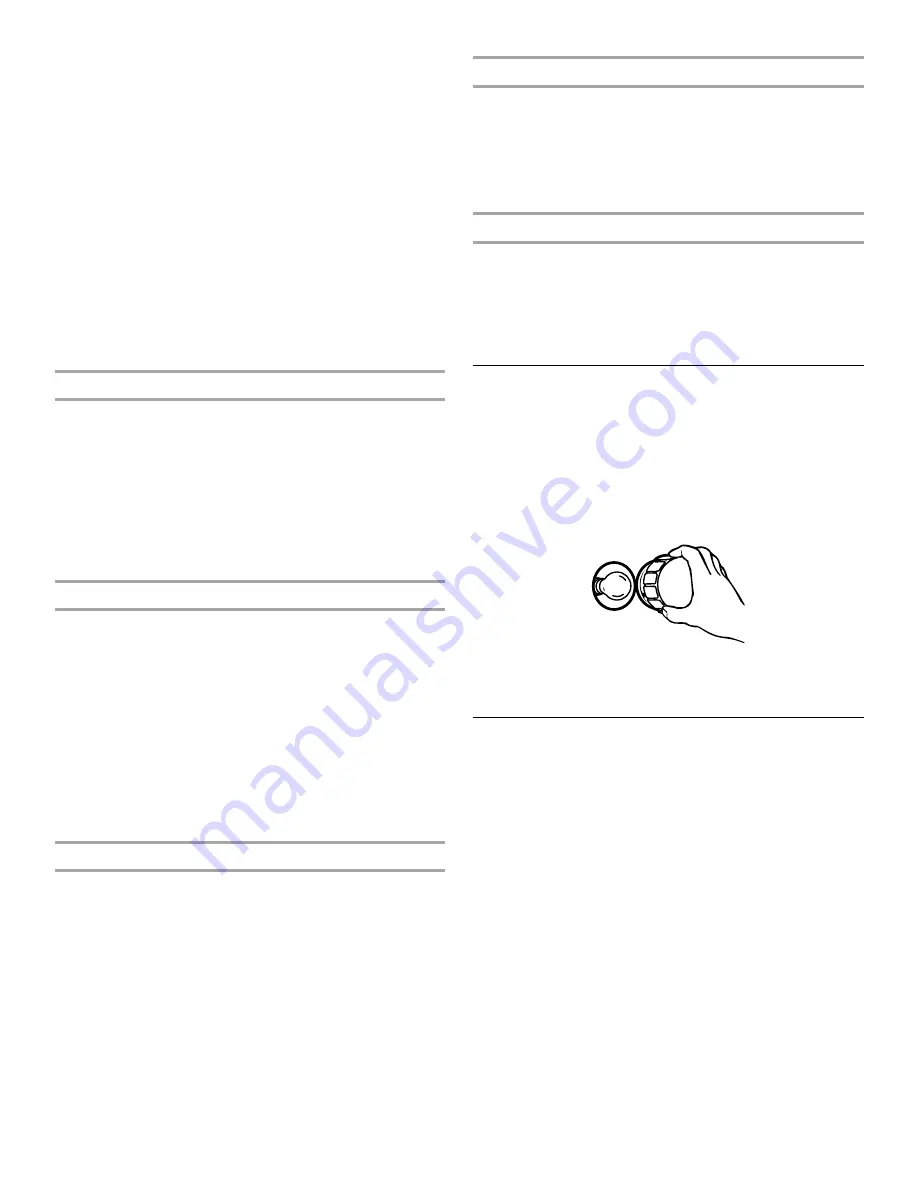
24
Burned-on soil
■
Cooktop Polishing Creme and Cooktop Scraper:
Rub creme into soil with damp paper towel. Hold scraper as
flat as possible on surface and scrape. Repeat for stubborn
spots. Polish entire cooktop with creme and paper towel.
Metal marks from aluminum and copper
■
Cooktop Polishing Creme:
Clean as soon as cooktop has cooled down. Rub creme into
surface with a damp paper towel or soft cloth. Continue
rubbing until white film disappears. The marks will not totally
disappear but after many cleanings become less noticeable.
Tiny scratches and abrasions
■
Cooktop Polishing Creme:
Rub creme into surface with a damp paper towel or soft
cloth. Continue rubbing until white film disappears. Scratches
and abrasions do not affect cooking performance and after
many cleanings become less noticeable.
COOKTOP CONTROLS
To avoid damage to the cooktop controls, do not use steel wool,
abrasive cleansers or oven cleaner.
To avoid damage, do not soak knobs.
When removing or replacing knobs, make sure knobs are in the
Off position.
Do not remove seals under knobs, if present.
Cleaning Method:
■
Warm, soapy water:
Pull knobs straight away from control panel to remove.
CONTROL PANEL
To avoid damage to the control panel, do not use abrasive
cleaners, steel-wool pads, gritty washcloths or abrasive paper
towels.
To avoid turning the controls on while cleaning, you may activate
the Control Lock feature (on some models). See “Control
Lockout” section.
Cleaning Method:
■
Glass cleaner and soft cloth or sponge: Apply glass cleaner
to soft cloth or sponge, not directly on panel.
■
All-Purpose Appliance Cleaner Part Number 31682 (not
included):
See “Assistance or Service” section to order.
OVEN DOOR EXTERIOR
Cleaning Method:
■
Glass cleaner and paper towels or nonabrasive plastic
scrubbing pad: Apply glass cleaner to soft cloth or sponge,
not directly on panel.
■
All-Purpose Appliance Cleaner Part Number 31682 (not
included):
See “Assistance or Service” section to order.
OVEN CAVITY
Do not use oven cleaners.
Food spills should be cleaned when oven cools. At high
temperatures, foods react with porcelain and staining, etching,
pitting or faint white spots can result.
Cleaning Method:
■
Self-Cleaning cycle: See “Self-Cleaning Cycle” first.
OVEN RACKS
Cleaning Method:
■
Self-Cleaning cycle: See “Self-Cleaning Cycle” first. Remove
racks, or they will discolor and become harder to slide. If this
happens, a light coating of vegetable oil applied to the rack
guides will help them slide.
■
Steel-wool pad
Oven Light
The ovens light is a standard 40-watt appliance bulb.
Before replacing, make sure the oven and cooktop are cool and
the control knobs are off.
To Replace:
1. Unplug range or disconnect power.
2. Turn the glass bulb cover in the back of the oven
counterclockwise to remove.
3. Turn bulb counterclockwise to remove from socket.
4. Replace bulb, then bulb cover by turning clockwise.
5. Plug in range or reconnect power.
Oven Door
IMPORTANT:
To avoid oven door glass breakage:
■
Do not close the oven door if the racks are not fully inserted
into the oven cavity or when bakeware extends past the front
edge of an oven rack.
■
Do not set objects on the glass surface of the oven door.
■
Do not hit glass surfaces with bakeware or other objects.
■
Do not wipe down glass surfaces until the oven has
completely cooled.
For normal range use, it is not suggested to remove the oven
door. However, if removal is necessary, make sure the oven is off
and cool. Then, follow these instructions. The oven door is heavy.
















































